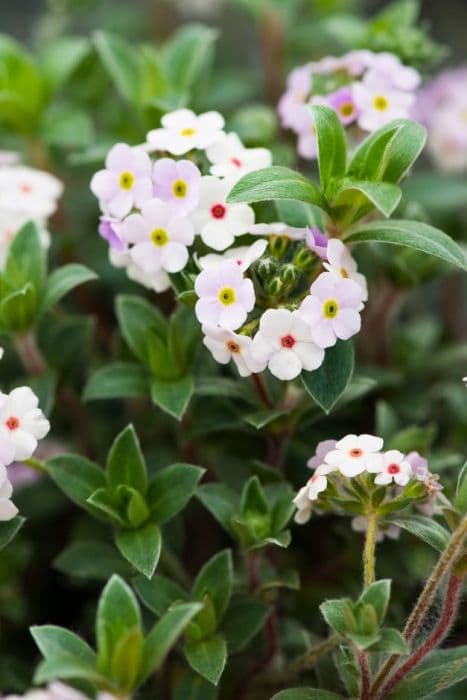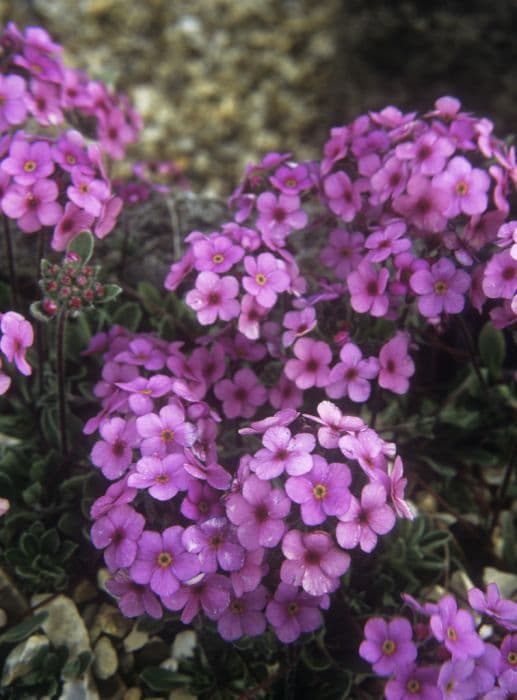Cyclamen Cyclamen 'Miracle Scarlet'

ABOUT
The Cyclamen 'Miracle Scarlet' is a striking ornamental plant known for its vibrant and vivid blossoms. The flowers are the standout feature, characterized by their intense scarlet hue. Each flower petal curls gracefully backwards, giving the blooms a refined and elegant appearance, almost like a group of miniature, brightly colored, twirling ballet skirts. Enhancing the show of color, the plant's foliage also contributes to its ornamental appeal. The leaves are heart or ivy-shaped with a dark green upper surface, often marbled with silver or pale green patterns. The contrast between the deep green of the leaves and the striking scarlet of the flowers creates a visually appealing display. The overall plant has a lush, compact appearance, with both flowers and foliage emerging from a central growing point, nestled close together to form a dense and attractive cluster. The leaves and flowers each emerge on their own stems, with the flowers typically rising above the foliage to showcase their beauty prominently. Cyclamen 'Miracle Scarlet' adds a pop of color and is often appreciated for its long-lasting flowers and decorative leaves that make it a popular choice for indoor decoration, especially during cooler months when its blooms are in season.
About this plant
 Names
NamesFamily
Primulaceae.
Synonyms
Persian Violet, Sowbread, Alpine Violet.
Common names
Cyclamen persicum 'Miracle Scarlet'.
 Toxicity
ToxicityTo humans
Cyclamen is generally considered to be toxic to humans if ingested. All parts of the plant contain toxic substances, but the tubers have the highest concentrations. If ingested, cyclamen can cause symptoms such as nausea, vomiting, and diarrhea. In large quantities, it may also lead to more severe effects including heart rhythm abnormalities, seizures, and paralysis. It is important to seek medical attention if ingestion occurs, especially for children, who may be more vulnerable to its toxic properties.
To pets
Cyclamen is also toxic to pets, including both cats and dogs. The plant contains compounds that can cause vomiting, diarrhea, and salivation if ingested. In severe cases, ingestion can lead to heart rhythm disturbances, seizures, and even death, particularly if the tubers are consumed, as they contain the highest concentrations of these toxic substances. If you suspect your pet has ingested cyclamen, it is crucial to contact a veterinarian immediately.
 Characteristics
CharacteristicsLife cycle
Perennials
Foliage type
Evergreen
Color of leaves
Green
Flower color
Scarlet
Height
6-9 inches (15-23 cm)
Spread
6-9 inches (15-23 cm)
Plant type
Bulb
Hardiness zones
5
Native area
Mediterranean
Benefits
 General Benefits
General Benefits- Decorative Flowers: Adds vibrant scarlet blooms to any indoor space, offering aesthetic appeal and enhancing home decor.
- Seasonal Interest: Flowers during the fall and winter months, providing color and interest during typically dormant periods for many other plants.
- Compact Growth: Its small size makes it ideal for windowsills, desks, or tabletops without needing a lot of space.
- Long Blooming Period: Known for having a lengthy flowering period, which can extend the enjoyment of its blooms.
- Gift Potential: Often given as a gift in the cooler months due to its attractive flowers and seasonal timing.
- Easy Care: Requires minimal maintenance, making it suitable for busy individuals or those new to gardening.
- Improves Mood: Having plants indoors, such as Cyclamen 'Miracle Scarlet', can enhance the mood and create a more inviting space.
 Medical Properties
Medical PropertiesThis plant is not used for medical purposes.
 Air-purifying Qualities
Air-purifying QualitiesThis plant is not specifically known for air purifying qualities.
 Other Uses
Other Uses- Decorative container gardens: Cyclamen can be used to add vibrant color and a touch of elegance to small container gardens or tabletop displays.
- Seasonal wreaths: The brightly colored flowers of the Cyclamen can be incorporated into seasonal wreaths for a unique and attractive twist.
- Fairy gardens: Cyclamen's small stature and whimsical flowers make it an ideal addition to fairy gardens, especially in shaded areas.
- Pressed flowers: Cyclamen blooms can be pressed and used in crafting, such as making personalized greeting cards or bookmarks.
- Ice cubes for events: Freeze Cyclamen petals in ice cubes to create an eye-catching element for punches and cold drinks at special events.
- Cake decoration: Edible varieties of Cyclamen flowers can be used to decorate cakes and desserts—ensure they are free of pesticides and safe for consumption.
- Photography props: The vivid colors and unique shape of Cyclamen flowers can provide an interesting and beautiful subject for macro photography projects.
- Wedding bouquets: Cyclamen can be added to wedding bouquets for bold splashes of color and seasonal relevance, particularly for fall and winter weddings.
- Education and science projects: Use Cyclamen to teach children about plant growth cycles, botany, and the care required for different types of plants.
- Gift plants: With their attractive flowers and leaves, Cyclamen plants make excellent and easy-care gifts for a variety of occasions.
Interesting Facts
 Feng Shui
Feng ShuiThe Cyclamen is not used in Feng Shui practice.
 Zodiac Sign Compitability
Zodiac Sign CompitabilityThe Cyclamen is not used in astrology practice.
 Plant Symbolism
Plant Symbolism- Love and Devotion: Cyclamens are often associated with sincere love and devotion due to their heart-shaped leaves and long-lasting flowers.
- Resignation and Goodbye: In some contexts, giving a cyclamen can symbolize a parting or resignation, as it may indicate a time to let go of something that once was.
- Sincerity: The upright growth and open face of the cyclamen's blooms are associated with openness and honesty in feelings.
- Compassion: The gentle appearance of cyclamen is sometimes seen as embodying compassion and tenderness in human relationships.
 Water
WaterCyclamen, or florist's cyclamen, prefers to be watered when the top inch of soil feels dry to the touch. The watering frequency can vary but typically, it's about once a week. It's crucial to water cyclamen from the bottom by filling a saucer under the pot to allow the plant to absorb moisture through drainage holes—this helps prevent water from getting on the leaves and crown, which can cause rot. You'll want to use roughly half a gallon every two weeks for a standard pot size, adjusting as necessary for the size of your plant and pot, as well as the humidity and temperature of your environment.
 Light
LightFlorist's cyclamen thrives in bright, indirect light. It is best kept in a location where it receives plenty of light but is protected from direct, harsh sunlight, such as a north or east-facing window. Direct sunlight, especially in the hotter months, can scorch the leaves and flowers, while too little light can lead to weak growth and fewer blooms.
 Temperature
TemperatureFor florist's cyclamen, the ideal temperature range lies between 60 and 70 degrees Fahrenheit. They can tolerate a minimum temperature of around 50 degrees Fahrenheit at night but should not be exposed to temperatures above 77 degrees Fahrenheit for extended periods, as this can cause the plant to go into dormancy. Cyclamen prefer cooler conditions and can struggle in consistently hot environments.
 Pruning
PruningFlorist's cyclamen should be pruned to remove yellowing or withered leaves and spent flowers. This helps to encourage new growth and maintain a tidy appearance. Typically, pruning is done as needed throughout the growing season. The best time to prune is when you see parts of the plant that are no longer thriving, ensuring you use clean, sharp scissors or pruning shears to make clean cuts.
 Cleaning
CleaningAs needed
 Soil
SoilCyclamen 'Miracle Scarlet' prefers a well-draining potting mix with plenty of organic matter. A mixture of potting soil, peat, and perlite or sand works well to keep the roots healthy. The ideal pH for Cyclamen is slightly acidic to neutral, ranging from pH 6.5 to 7.0.
 Repotting
RepottingCyclamen 'Miracle Scarlet' typically requires repotting every one to two years, preferably when it is not actively blooming. The best time to repot is after the plant has finished flowering and when new growth begins.
 Humidity & Misting
Humidity & MistingCyclamen 'Miracle Scarlet' thrives in moderate to high humidity levels, ideally between 40-50%. It is important to avoid excessive humidity, which can promote fungal diseases.
 Suitable locations
Suitable locationsIndoor
Place in a bright spot, avoid direct sun, and keep soil moist.
Outdoor
Shelter from direct sun; plant in dappled shade and protect from frost.
Hardiness zone
5-9 USDA
 Life cycle
Life cycleCyclamen 'Miracle Scarlet', commonly known as Persian Violet, begins its life as a tuber, which sprouts roots, leaves, and eventually flowers as temperatures cool, typically in the fall. The heart-shaped leaves unfurl, providing photosynthesis energy to fuel growth. The striking scarlet flowers bloom above the foliage, usually in late winter or early spring, depending on the climate. After flowering, the plant sets seed, which is dispersed for propagation, although cultivated varieties are often propagated by dividing the tubers. As temperatures rise in late spring or summer, the plant goes dormant, with foliage dying back to conserve energy in the tuber. Dormancy lasts through the hot months until cooler temperatures signal the start of a new growth cycle.
 Propogation
PropogationPropogation time
Spring-Early Summer
The most popular method of propagation for Cyclamen 'Miracle Scarlet', commonly known as the Florist's Cyclamen, is through seed sowing. Propagation is typically done in the late winter or early spring when the plant naturally goes dormant. To propagate by seeds, one must first collect the seeds from the Cyclamen once the flower has faded and the seed pod has matured. These seeds can then be sown in a tray or pot filled with a well-draining soil mixture. The soil should be kept moist but not waterlogged, and the seeds require darkness for germination, so they should be covered lightly with soil. The germination process is slow and can take several weeks to months, with temperatures maintained around 65 degrees Fahrenheit (18 degrees Celsius). Once seedlings become large enough to handle, they can be potted into individual containers.









